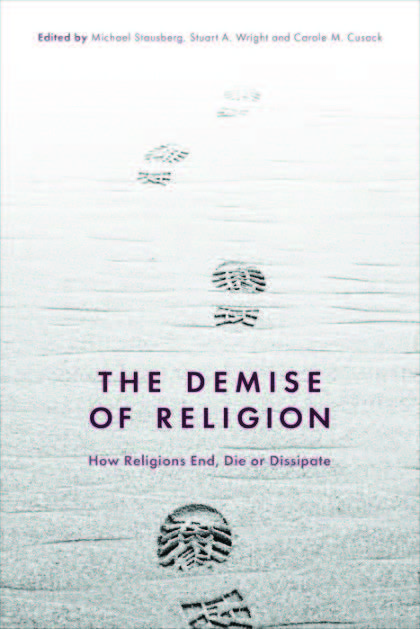

![]() Even if it is not the case across the board, we often hear more of religious decline than vitality today, so that the new book The Demise of Religion (Bloomsbury Academic, $115) seems to fit the mood. But the anthology, edited by Michael Strausberg, Stuart A. Wright, and Carole M. Cusack, actually delivers a more nuanced message than the forecasts of inevitable religious decline and secularization. The varied case studies suggest that just as religious organizations can die, they can also be revived and reinvent themselves, with new related ones being born. The editors outline several trajectories of the demise of religions (a different phenomenon than the more subjective state of religious decline), ranging from leadership issues to the loss of economic resources, disruptions in intergenerational transmission, failed prophecies, violent self-annihilation (mass suicides and murder), and state actions against religions.
Even if it is not the case across the board, we often hear more of religious decline than vitality today, so that the new book The Demise of Religion (Bloomsbury Academic, $115) seems to fit the mood. But the anthology, edited by Michael Strausberg, Stuart A. Wright, and Carole M. Cusack, actually delivers a more nuanced message than the forecasts of inevitable religious decline and secularization. The varied case studies suggest that just as religious organizations can die, they can also be revived and reinvent themselves, with new related ones being born. The editors outline several trajectories of the demise of religions (a different phenomenon than the more subjective state of religious decline), ranging from leadership issues to the loss of economic resources, disruptions in intergenerational transmission, failed prophecies, violent self-annihilation (mass suicides and murder), and state actions against religions.
The subsequent chapters flesh out these different trajectories with case studies of demised religions, such as: Japan’s Aum Shinrikyo, which persists in national memory for its terrorist actions; the Seajle megachurch Mars Hill and how the scandals relating to the authoritarian and charismatic ministry of the founding pastor—and protests from members and others—resulted in the congregation’s dissolution; and the several instances of government repression and pressure that resulted in religious demises, such as with the Branch Davidians, the Mormon fundamentalist Yearning for Zion Ranch, and the French New Age Horus community. Standing somewhat apart from the other contributions is anthropologist Joel Robbins’ chapter on how anthropology needs to take more seriously religious change and demise rather than persistence. He argues that his case study shows how an indigenous religion in Papua-New Guinea no longer “worked” for its adherents because of institutional changes and pressures and how it was replaced by Pentecostal Christianity.